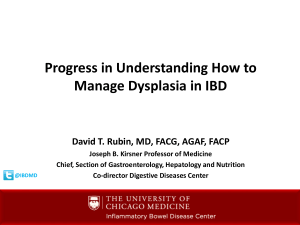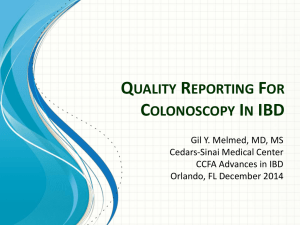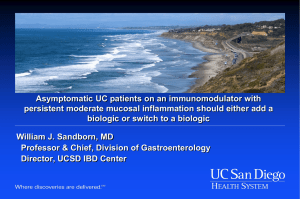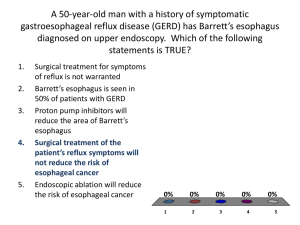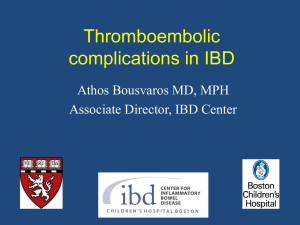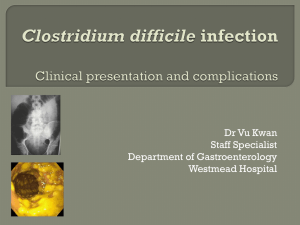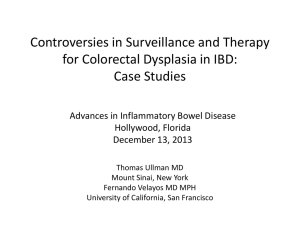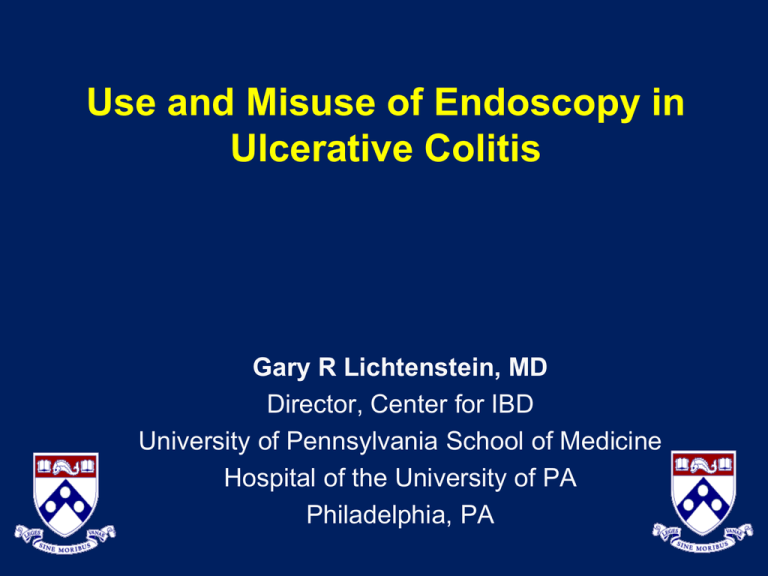
Use and Misuse of Endoscopy in
Ulcerative Colitis
Gary R Lichtenstein, MD
Director, Center for IBD
University of Pennsylvania School of Medicine
Hospital of the University of PA
Philadelphia, PA
Gary Lichtenstein, MD
Disclosures
Research, Advisory, and/or Honorarium
Abbott
Luitpold /
American
Regent
Santarus
Millenium
Shire
Elan
Ono
Takeda
Ferring
Pfizer
UCB
Hospira
Prometheus
Warner Chilcott
Meda
Salix
Alaven
Bristol-Myers
Squibb
ScheringPlough
Uses of Endoscopy in IBD
•
•
•
•
•
•
•
•
•
•
Diagnosis
Disease extent
Prognostication
Assessment of Activity/Healing
Stricture evaluation and dilation
Dysplasia Surveillance
Diagnose/Control Bleeding
Pouch Evaluation
Endoscopic Ultrasound
Video Capsule Endoscopy
I. Diagnosis
• The Gold Standard for Diagnosis of UC
(also Crohn’s colitis and ileocolitis)
A. Periappendiceal Red Patch
Rubin D, et al. Dig Dis Sci (2010) 55:3495–3501
A. Periappendiceal Red Patch
• PARP is NOT Crohn’s Disease
• Present in 29/367 (7.9%) patients
•
•
PARP- Periappendiceal Red Patch
Rubin D, et al. Dig Dis Sci (2010) 55:3495–3501
I. Diagnosis
• Mimickers of Crohn’s ileitis and colitis
? Aphthous Ulcer
•
Exudate washes off
Yes
Diagnosis: Early Crohn’s Disease
? Aphthous Ulcer
•
Excavation
Yes
Diagnosis: Early Crohn’s Disease
? Aphthous Ulcers
•
Exudate does not
wash off
No – Lymphoid Aggregates
Diagnosis: Normal TI
? Aphthous Ulcers in the Colon
•
•
Exudate washes off
No underlying
excavation
No – Pseudomembranous Colitis
I. Diagnosis
• Lymphoid aggregates mimic aphthous
ulcerations
• Pseudmembranes in colon mimic
aphthous ulcers
– Lead to erroneous suggestion of the presence
of Crohn’s Disease in patients with Ulcerative
Colitis
II. Need to Biopsy
Patient Presentation
• Male, age 59 yrs. old
College Professor at a
University in Louisiana
well until 1 year ago
• Symptoms
– Pain
– Diarrhea (6-8 loose
stools/day)
– 5-lb weight loss
• Physical examination
– Tender LLQ
– No mass
• Laboratory values
– WBC: 4,500 cells/µL
– Hgb: 10.5 g/dL
– CRP: 5.5 mg/dL
• Laboratory values
– Albumin: 3.5 g/dL
– Stool – C & S, C diff, O & Pnegative
• Colonoscopy
– Erythematous, granular friable
mucosa from the anal verge to
35 cm
– No biopsies
• Rx
– Prednisone 40 with taper 5mg
every week with symptom
resolution
– At 20 mg a day diarrhea recurs.
CRP = C-reactive protein; LLQ = right lower quadrant.
Repeat Colonoscopy
• Colonoscopy: Loss of vascular pattern, granularity,
pinpoint erosions, touch friability to 35 cm (left colon)
with superficial ulcerations. Random biopsies obtained.
Need to Biopsy
Qu Z, et. al . Human Pathology . 2009; 40, 572–577
Strongyloides Colitis
Endemic areas :
- Appalachian region and Louisiana in the
United States
- Regions with large influx of tourists and
emigrants from these endemic areas, southeastern
Asia, and southern, eastern, and central Europe
also have high incidence and prevalence of the
disease .
Who Gets Disease:
- The infection may remain clinically indolent.
- When the host is immune-compromised,
hyperinfection syndrome (i.e., larvae overload in
the lung and involvement of the rest of the
gastrointestinal system) and disseminated
strongyloidiasis (i.e., involvement of other organs)
occur with a mortality rate near 90%
Qu Z, et. al . Human Pathology . 2009; 40, 572–577
Strongyloides Colitis
Qu Z, et. al . Human Pathology . 2009; 40, 572–577
Infectious Colitis that Mimics UC
Rameshshanker R., et. al . World J Gastrointest Endosc 2012 June 16; 4(6): 201-211
Parachute use to prevent death and major trauma
related to gravitational challenge: Systematic
review of randomised controlled trials
No Randomized Trials
CONCLUSION:
Parachutes reduce the risk of injury after gravitational challenge, but
their effectiveness has not been proved with randomised controlled
trials
Smith GCS, Pell JP. Br Med J. 2003;327:1549.
III. Disease Extent
• Assess extent of disease
– when having active symptoms
• Mucosa may have complete endoscopic
healing or remission with when in
remission.
Disease Progression
in Ulcerative Colitis
Farmer1
Stonnington2
Leijonmarck3
Langholz4
Sinclair5
1116
182
1586
1161
537
Period of study
1960-83
1935-79
1955-84
1962-87
1967-76
Type of practice
Referral
Community
Community
Community
Community
63%
~67%
63%
80%
89%
46%
70%
29%
Not given
Not given
30% at 10
years
Number of
patients
Initial extent <
pancolitis
Extension
From proctitis
From left-sided
colitis
Adapted from Miner PM. In Kirsner JB, ed. Inflammatory Bowel Disease, 5th edition. Philadelphia, Pa:
WB Saunders Company; 2000.
1. Farmer RG, et al. Dig Dis Sci. 1993;38:1137-1146. 2. Stonnington CM, et al. Gut. 1987;28:1261-1266.
IV. Prognostication
• Assess histology to predict future
probability of flare
• Mucosal healing predicts
– lower colectomy rate
– less steroid use in the future
• Treat individuals with potential for
aggressive behavior with appropriately
aggressive therapy.
Histologic Inflammation Predicts Relapse
in UC Independent of Symptoms
Acute inflammatory cell infiltrate
(N=27)
Crypt abscesses
(N=27)
100
P=0.02
80
60
52%
40
25%
20
Patients with
relapse (%)
Patients with
relapse (%)
100
80
Infiltrate
60
40
27%
20
No infiltrate
Presence
Mucin depletion
(N=27)
Absence
Breaches in surface epithelium
(N=27)
100
80
P<0.02
56%
40
26%
20
Patients with
relapse (%)
100
Patients with
relapse (%)
P<0.005
0
0
60
78%
80
75%
P=0.1
60
31%
40
20
0
0
Depletion
Presence
Presence
Absence
Reproduced from Gut 32(2):174-178. Riley SA et al, 1991, with permission from BMJ Publishing Group Ltd.
Histologic Findings of Basal
Plasmacystosis Predict Shorter Time to
Relapse in UC
Proportion of Patients
in Remission
1
0.75
0.5
0.25
Basal Plasmacytosis
Absence
Presence
0
0
2
4
6
8
10
12
Months of Study
Reprinted from Gastroenterology 120, Bitton A et al, Clinical, biological, and
histologic parameters as predictors of relapse in ulcerative colitis, 13-20. Copyright
(2001), with permission from the American Gastroenterological Association.
Mucosal Healing Can Impact the Need for Surgery
(IBSEN Study – Frøslie et al 2007, Solberg et al 2008)
• Population-based cohort of IBD patients followed from 1990 to 1994 in
Norway1
• Patients were treated with conventional therapies not including biologics1
• Among 495 pts available for analysis, mucosal healing observed at 1 year in
50% (UC) and 38% (CD)1
• In UC, mucosal healing was significantly associated with:
– less inflammation
– less corticosteroid treatment 5 years after diagnosis1
– fewer surgeries by 5 years1
• When f/u extended to 10 years:
– significantly fewer surgeries in patients with mucosal healing at 1 year2
25RGU11005
1. Frøslie KF, et al. Gastroenterology. 2007;133:412-422.
2. Solberg IC, et al. Gut. 2008;57(Suppl II):A15. Abstract OP070.
Impact of Mucosal Damage on Subsequent
Colectomy in Ulcerative Colitis
Proportion of UC Patients
Not Colectomized
100
90
Patients without
endoscopic activity
at 1-year visit
80
70
60
P<0.05
50
40
30
Patients with
endoscopic activity
at 1-year visit
20
10
0
0
1
2
3
4
5
6
Time in Years After 1-Year Visit
7
8
Patients with compromised mucosa 1 year after
diagnosis showed a trend toward more surgeries.
Frøslie KF, et al. Gastroenterology. 2007;133:412-422.
Week 8 Mayo Endoscopy Subscore Predicts Corticosteroid-Free
Symptomatic Remission at Week 30 During Anti-TNF Antibody
Therapy- Results from ACT I and ACT II
Week 8 Mayo
endoscopy
Subscore
Corticosteroid-free
symptomatic
Remission, n/n (%)
0
30/65 (46)
1
35/102 (34)
2
8/71 (11)
3
2/31 (6.5)
P value
<.0001
Colombel JF, et al. Gastroenterology. 2011;141:1194-1
Proportion without colectomy
or commercial infliximab use
Mucosal Healing Correlates to Rate of
Colectomy: Results from ACT 1 (Infliximab)
1.00
0.75
0.50
0
10
20
30
40
50
Time to colectomy or commercial infliximab use (weeks)
0 = NORMAL
1 = MILD
Colombel JF, et al. Gastroenterology. 2011;141:1194-1201.
2 = MODERATE
3 = SEVERE
Risk of Colectomy in Severe UC
Patients with Severe Ulcerations
• Retrospective cohort
• Prior to anti-TNF era
• 85 consecutive patients
with active UC
• Severe endoscopic
Lesions (SELs):
•
•
•
•
93%
No SEL
SEL
Colectomy
9/39 pts
Deep Ulcers
Well-like Ulcers
Large Mucosal Erosions
Extensive Loss of Mucosal
Layer with or without
Residual Mucosal Areas
26%
Colectomy
43/46 pts
OR= 41, (95%
CI 10.5-164)
Carbonnel F, et al. Dig Dis Sci. 1994 Jul;39(7):1550-7.
Evolving Approach to Treating UC
Current: Modern Approach
•
Assessment of prognosis
• “Optimization” of azathioprine/6-MP (dose or metabolites)
• Earlier adoption of biologic therapy
• Appreciation for the implications of a healed mucosa
Near Future Approach
•
Newer therapies with favorable safety and side-effect profiles
• Individualized therapy based on genetics and physiology
• Treatment to hard endpoints like mucosal healing or surrogates
of it
• Disease monitoring to prevent relapse
V. Dysplasia Surveillance
Current ACG Surveillance Guidelines 2010
(Secondary Prevention)
• Who: left-sided or pan-UC more than 8-10 years (exception: PSC and UC- start
immediately)
• Technique: random biopsies every 10 cm of mucosa; at least 33 biopsies;
extra focus on nodules, masses, strictures
• How often: q 6 months-2 years
• Outcome (reviewed by second pathologist):
–
–
–
–
High-grade dysplasia: colectomy
Low-grade dysplasia: consider colectomy
Indefinite dysplasia: increase surveillance?
Atypia or indeterminate: treatment of active disease, repeat colonoscopy and biopsies
Kornbluth and Sachar, Ulcerative colitis practice guidelines (update). Am J Gastroenterol, 2010.
Myth
Most Dysplasia is Flat !
Random Biopsies Sample a Very
Small Surface Area of the
Colorectum
• Surface area of colorectum: 1578.1 + 301.0 cm2
• Surface area of biopsy forceps: 2.2-5 mm2
• Recommended “at least 33 biopsies”
• Percent surface area with this approach: 0.05%-
0.1%
Biopsy Numbers Required in
Dysplasia and Cancer Detection
Sadahiro S. et al. Cancer, 1991.
Rubin CE, et al. Gastroenterol, 1992.
Kornbluth and Sachar. Am J Gastroenterol, 2004.
Confidence
Dysplasia
Cancer
90%
33
35
95%
56
64
The World is not Flat
Dysplasia is Often Not “Invisible”!
• “Invisible”: indistinguishable from
surrounding inflamed or quiescent
mucosa
• “Visible”
– Polypoid “adenoma-like” lesion
– Irregular borders “spreading” lesion, not
endoscopically resectable (DALM)
– Mass
– Stricture
• Optical colonoscopy sensitivity
(retrospective studies1,2):
– Per lesion sensitivity: 61.6%-77.3%
– Per patient sensitivity: 78.3%-89.3%
1Rutter
MD, et al. Gastrointestinal Endoscopy, 2004 ;60:334–339
DT, et al. Gastrointestinal Endoscopy, 2007; 65:998-1004.
3 Blonski W et al. Scand J. Gastronterol 2008;43(6):698-703.
2Rubin
Will New Technology Increase Detection of
Neoplasia in IBD?
• High Definition Colonoscopes
• Chromoendoscopy
– Dye spraying (Indigo Carmine, Methylene Blue)
– Narrow band imaging
•
•
•
•
•
•
Magnifying endoscopy
Fluorescence endoscopy
Optical coherence tomography
Confocal laser endomicroscopy
Fecal DNA?
Molecular assessment of biopsies?
Inflammatory
polyps
Dysplasia Associated Lesion or
Mass
Conventional Polyps: Endoscopic
Features Suggesting Malignancy
Central Umbilication
Firm (or hard) consistency when the head
is pushed with a snare or forceps
Satellite Lesions
Irregular surface contour
Focal ulceration
Broadening of the stalk
Chromoendsocopy
Improves ability to detect lesions
Improves ability to detect full extent of
lesions
Ability to differentiate neoplastic from non
neoplastic lesions
Chromoendoscopy for Dysplasia in UC
Kiesslich R et al. Gastroenterol Clin N Am. 2012;41: 291–302
Modified Kudo Criteria
Type III, IV and V : are considered to be features of neoplastic lesions
Kudo S, et al Gastrointest Endosc. 1996;44:95–96
Chromoendoscopy : Indigo Carmine
Before (left) and after (right) application of Indigo Carmine.
Pit Patterns with Chromoendoscopy
Conclusion
PARP is common in UC and does not
mean CD is present
Biopsy is important in diagnosis of UC
Aphthous ulcers may be confused with
other entities
Lymphoid aggregates
C diff
Endoscopy can help establish patient
prognosis
SELs
Mucosal healing
Steroid Free Remission
Colectomy
Conclusion
Most dysplasia is raised- not flat
Chromoendoscopy
Improves ability to detect lesions
Improves ability to detect full extent of
lesions
Ability to differentiate neoplastic from non
neoplastic lesions


